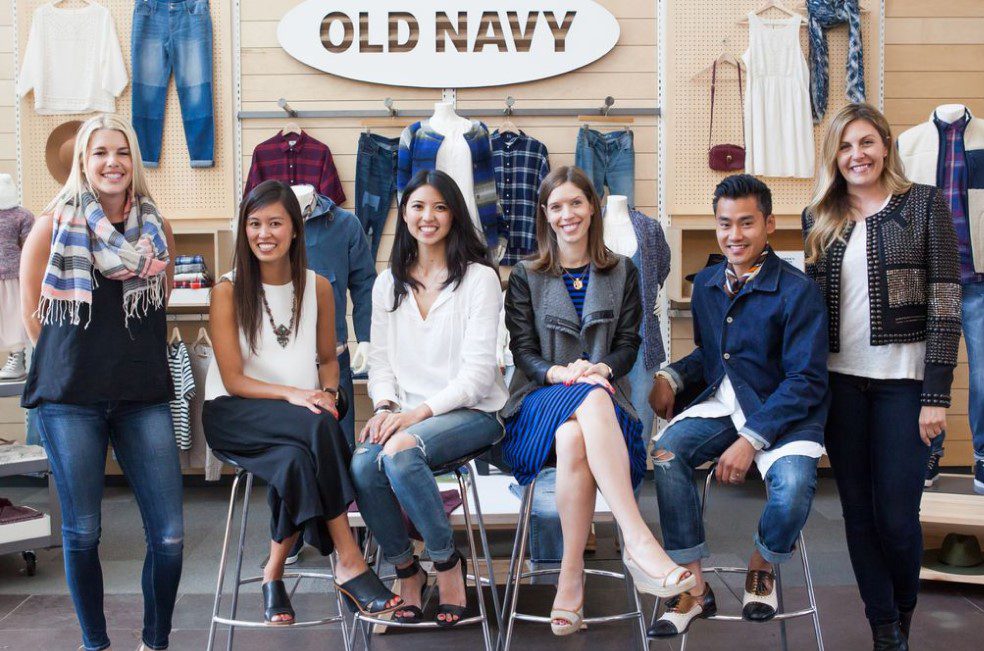Old Navy: Peaks and Troughs Along the Growth Journey of Gap’s Crown Jewel
It would be challenging to find anyone in the United States who would not recognize the blue-and-white logo of Old Navy – Gap’s golden child and top performing brand. Undoubtedly, Old Navy has experienced such a phenomenal success that the retail powerhouse establishes a presence in almost every single city in the country and has been a robust cornerstone within the retail clothing landscape just since it seemed to pop out of thin air back in the 1990s.
Whilst the Gap’s oldest brand has recently come up against a handful of tough challenges to retain its customer base, there is no denying that Old Navy has grown considerably to become the company’s largest brand. The growth trajectory of Gap’s “crown jewel” emerges as an intriguing case study within the fashion sphere. Then, let’s read on to uncover!
Old Navy & Its Growth Journey Towards the Gap’s Crown Jewel
Golden History of Old Navy Starting with The Gap
Old Navy’s story begins in San Francisco back in 1969 when the 40-years-old Donald G. Fisher got frustrated at being unable to find a decent pair of jeans and decided to start his first store: The Gap. At its first location, The Gap emerged as a place to buy low-priced jeans and music records. Unexpectedly, this store was such a stunning success that Fisher was able to expand his idea at a lightning pace. Astonishingly, by the mid-1970s, The Gap established its nationwide presence with staggering 200 stores spreading across 20 states. By the year 1980, The Gap Inc. was a publicly-traded company, bringing in over $300 million in sales and opening up to 80 new stores on an annual basis.
Donald G. Fisher was succeeded by Millard Drexler, who continued to expand the chain throughout the 1980s. Then, in 1983, The Gap expanded with a second chain, buying out the Banana Republic that thrived as an upscale version of The Gap.
Though, given The Gap’s phenomenal success, the 1980s did not pass without any hiccups. Mostly forgotten by now, two company failures included a sportswear chain called Hemisphere, which it later sold. Besides, the company’s foray into the furniture business was also short-lived with its brief ownership of the Pottery Barn retail chain.
Gap Warehouse: Old Navy’s First Incarnation
Twenty years of successful sales did not go unnoticed. In the early 1990s, there existed rumors that rival company Dayton Hudson Corp., the owner of Target and Mervyn’s, was planning on making a competitive move on The Gap’s market share by opening a rival clothing-store chain with lower prices. Upon hearing this, Millard Drexler anticipated the potential threats— as well as awaiting opportunities.
Consequently, Drexler arrived at one critical decision to make strategic moves before the competitor. Particularly, he had his staff go on a discount shopping spree: They went to local retailers including Walmart, Target, and J.C. Penney to purchase all the clothes and accessories they could find in the $10 price range. When they returned with their bags, Drexler arranged all of their purchases on the boardroom table and then had his advisers take a look. This was, they defined the golden opportunity for a new type of store.
The Gap contacted its network of overseas garment factories to ask about producing new lines of clothing with inexpensive fabrics. In August 1993, The Gap converted some of its stores into its new discount-clothing chain, originally named Gap Warehouse.

The Official Inception of Old Navy
Since the new Gap Warehouse stores were a huge hit, executives at The Gap – just after a few weeks, decided that the new chain needed its own identity. And after some consideration, Drexler decided on “Old Navy” which was named after a café and bar in Paris located on Boulevard Saint-Germain, which has since closed.
“We didn’t take ourselves too seriously, and we broke the industry’s rules,” the Gap Inc. corporate page says of its Old Navy brand. “We said fashion didn’t have to be just for rich people — it could be for everyone.”
The first Old Navy store opened in 1994 in Colmar, California, with the aim to bring cheaper fashion to the masses. Widely promoted as a media event with free giveaways, the company got Cindy Crawford to appear and to sign autographs.
After just one year in business, Old Navy had opened 59 stores with $120 million in sales. In 1995, it opened its flagship store in Manhattan and expanded to 131 stores with $420 million in sales.
In its early days, Old Navy stores were designed to be significantly larger than Gap stores, in order to provide more of a value-store feel along with an industrial aesthetic. Actually, the brand stores were about double the size of The Gap stores, selling jeans for $22 and T-shirts for just $7 in industrial-styled stores with cement floors, chrome fixtures, and exposed pipes.
Building upon Old Navy’s early success, the company looked to partner with celebrities and build out advertising campaigns. Besides, in 1997, Old Navy began airing the first of its traditionally quirky television commercials, starring fashion editor Carrie Donovan, which would set the tone for campaigns over the decades.
Before long, the Old Navy name was everywhere. The year of 1997 marked a historical milestone when Old Navy became the first retail chain to reach $1 billion in sales in under four years.
Old Navy at the Turn of the Century
In 1999, Old Navy changed its course – but not its speed – when Jenny Ming became president of the company. Under her leadership, the clothing brand did continue to expand and dominate the retail clothing market. By the beginning of the new century, Old Navy has “boasted” over 510 stores since its inception in 1994.
When it comes to the retailer’s stunning success, one crucial “ingredient” was the fact that Old Navy had reached beyond its target market, driving a higher-spending customer base than the company originally targeted. Actually, an NDP Group survey revealed that over 70% of Old Navy revenue came from households earning $50,000 or more.
Notwithstanding that, its retailing success stuttered in 2000 since its plans to expand internationally took a setback when distribution problems flooded the chain with excess inventory. Old Navy hit its first bump in the road when the company reported declining sales as a result of a strategy that neglected its over-30 shoppers.
Despite the troubles, Old Navy continued to eye expansion: notably, in 2001, the brand launched 12 stores in Ontario, Canada on the same day. After 10 years of constant growth, Old Navy slowed the number of stores it opened. In 2004, there were 844 stores in its chain, generating roughly $16 billion in sales annually and representing 40% of Gap Inc.’s revenue.
Also in 2004, Old Navy celebrated a decade in business. By then, Old Navy had become known as a one-stop shop for the entire family. In the mid-2000s, the company continued to raise its profile with the help of celebrities. Stars including Betty White came out en masse to a series of high-profile events empowering the brand to elevate its image. Other superstars working with the retail clothing brand were Pete Wentz and Ashlee Simpson, Jessica Biel, Arianna Huffington, among others. Furthermore, Old Navy did team with notables such as Mark Wahlberg on charity events like a 2006 effort with the Boys & Girls Club.
Since 2005, Old Navy has also offered plus sizes, expanding its customer demographic. Over the course of the early 2000s, the brand stores also became the go-to place for items such as multi-colored bargain flip flops as well as fun fuzzy socks. Plus, Old Navy has long been beloved for its Fourth of July apparel. What should also be noted is that Old Navy made continuous efforts to increase its visibility, especially by sponsoring major cultural events like the American Music Awards.

Yet, as a result of the 2009 financial crisis and recession, Old Navy hit another slump, joining many other retailers in a period of sales declines.
Marked Efforts to Revitalize the Brand
By 2012, acknowledging the fact that Old Navy’s growth had begun to stagnate, executives at The Gap Inc. decided that a change was in order if Old Navy was to continue its success. After evaluating the fashion landscape, they decided that H&M was their main competitor and appointed Stefan Larsson as president. Widely credited with revitalizing the brand, Larsson did leverage his background at H&M to bring in more fashionable styles similar to the fast-fashion model.
In fact, Larsson hired new designers recruited from such fashion behemoths as Reebok, Nike, The North Face, and Coach to come to Old Navy and work on new clothing lines. By 2015, Old Navy revenue reached $6 billion in the U.S. alone. Once again, Old Navy was at its peak, leading the way for Gap as its most profitable and successful brand. Having accomplished the success for which he was hired, Larsson left to work for Ralph Lauren, and Sonia Syngal became the next president and CEO of Old Navy.
Old Navy and The Gap: The Spin-Off Plan That Gets Halted

The Gap’s Decision for Spin-Off & Old Navy’s Upward Growth
In 2018, Old Navy was regarded as the toast of Wall Street. Having reported several consecutive years of sales growth, Old Navy gained a solid reputation among analysts as being the saving grace of its parent company.
Yet, markedly, Old Navy’s success stood in stark contrast to Gap Inc.’s core, namesake brand, which was experiencing quarter after quarter of declining sales and shuttering stores. From the perspective of Neil Saunders, managing director of GlobalData Retail, in a note to clients in November 2018, “The usual story reveals itself: Old Navy is doing all of the heavy lifting while the Gap brand languishes.” Actually, many other analysts even called for The Gap’s board to rename the company Old Navy.
And ultimately, The Gap was taking notice. In February 2019, The Gap announced that it would be splitting the company in two and that Old Navy would be going out on its own. The news did not only send shockwaves through the market but was also likely to distract investors from Old Navy’s uncharacteristically flat sales numbers at the back end of the previous year.

As the year progressed, there existed a continuing pattern of weaker sales. Particularly, in the first two quarters of 2019, Old Navy’s same-store sales decreased by 1% and 5%, respectively, and The Gap’s CEO Art Peck was forced to address its recent weakness in a call with investors. “Our results were not what we expect from this powerhouse brand,” Art Peck stated, commenting on Old Navy’s first-quarter earnings results. As stated by the management teams, the dip could be attributable to issues related to the product offerings that it had since addressed.
In the early of November 2019, Gap made another staggering announcement that Peck would be stepping down from his role effective immediately while also sharing details on its third-quarter earnings, which revealed that sales had dropped once more at Old Navy, that time by 4%.
Such news left Wall Street wondering whether, with Peck’s departure and its sales continuing to struggle, Old Navy was still in a position to go out on its own. Regarding that concern, a spokesperson for Old Navy declined to comment when reached by Business Insider.
When it comes to the Old Navy’s issues, some business analysts attributed this to the fact that “They [Old Navy’s teams] didn’t take any risks”. From their standpoints, one of the primary reasons why the brand experienced a sales dip in the past few months was that it temporarily lost sight of what customers most love about the brand: its playful and whimsical styles.
“I really think Old Navy has forgotten about the DNA of the brand,” commented Gabriella Santaniello, Analyst, and Founder of retail research firm A Line Partners. Santaniello said she noticed a weakness in the retailer’s assortment back in December 2018 and thought that it hasn’t improved since then. “There were a lot of product misses,” she shared, recalling the past 10 months. “The assortments overall lacked fashion, the color palettes were off, they didn’t take any risks so anything that was remotely fashionable sold out immediately.”
One of the most serious problems was that it did not jump on the wide-leg pant trend quickly enough, Santaniello added, instead, it continued to double down on an old favorite – the Rockstar skinny jeans. For Santaniello, a fashion miss like this spoke to a more serious structural issue on the team. “You’re a fashion team. You can’t just rest on your laurels — you’ve got to be on to the next thing,” she said.
In addition, Neil Saunders, Managing Director of GlobalData Retail, did describe Old Navy’s 2019 collections as “bland.” In particular, “although Old Navy is not a fashion destination, it has traditionally put out some exciting and on-trend edits that keep consumers visiting and buying. There has been a noticeable absence of these for the past couple of seasons and it has reduced conversion and visitation rates.”
Besides, according to Neil Saunders, the competitive retailing landscape may be another reason to blame on. “The market has become significantly more competitive over the past half-year. There are more discounting and more promotions,” he said. Target, Walmart, TJ Maxx, and Primark, to name just a few, are all going after the same customer segments with cheap and trendy clothes.
What’s more, there exists a “slow-burning” trend among some younger American shoppers to look for more sustainable apparel. Whilst this was not likely to leave a major impact on sales at the moment, it was “still unhelpful in taking the edge of growth.”

At that point in time, the most pivotal question was whether Old Navy could navigate against what could end up being a short-term blip and win back any customers who might have walked away in the meantime. “The customer is not brand loyal …they’ve clearly found other places to shop. The true test will be to see if they can ever get the customer back,” stated Santaniello.
Meanwhile, she’s doubtful about the proposed split of the company. “I think at this point, their biggest concern has to be getting Old Navy back on the right track … Breaking off has probably moved down a bit on the totem pole. I really don’t think that is something that they are going to want to focus on right now,” she said, adding, “It’s going to be really hard to convince anyone to spin it off if they keep underperforming.”
Plans to Split Old Navy Being Called Off
Such a concern went on until 2020 January when The Gap announced to cancel its plans to split Old Navy into a separate public company. Another announcement made by the apparel maker was that Neil Fiske, president and CEO of the Gap brand, was departing. Its shares shot up more than 9% in after-hours trading on the news.
“The plan to separate was rooted in our commitment to value creation from our portfolio of iconic brands,” Gap interim president and CEO Robert Fisher told in a statement. “While the objectives of the separation remain relevant, our board of directors has concluded that the cost and complexity of splitting into two companies, combined with softer business performance, limited our ability to create appropriate value from separation.”
Going on to further explain the “cost and complexity” of the spin-off plan, he added, “The work we’ve done to prepare for the spin shone a bright light on operational inefficiencies and areas for improvement.”
As regards Neil Fiskes’s departure, Gap said that it intended to appoint a new CEO to oversee its full portfolio of brands including the Banana Republic, Athleta, and Hill City. And by March 2020, the new leader turns out to be Sonia Syngal, one of the few female CEOs in the Fortune 500.
Going back to the decision to scrap the spit-off plans, this proved to a wise decision – at least for the time being – when Old Navy served as one amongst two Gap’s brands leading the company’s turnaround after the COVID-19 economic crisis. Specifically, The Gap’s turnaround is being driven by the Old Navy and Athleta brands as the namesake and Banana Republic brands continue to struggle during the pandemic.

Whilst Gap’s stock inclined to sink, the apparel retailer’s third-quarter earnings reported that Old Navy sales rose 15%, with comparable sales up 17% for the quarter. Plus, the company notes that 75% of that brand’s fleet of stores can be found “off-mall,” which puts Old Navy at an advantage.
Taking a deeper look into Old Navy’s positive performance, GlobalData attributes its successful quarter to its focus on comfortable clothing, “which is one of the few apparel categories that has held up relatively well during the pandemic,” as well as affordable pricing, which has become more important to shoppers facing financial uncertainty.
Furthermore, Old Navy “has remained cheerful and upbeat at a time when consumers have been looking for relief from the bleakness of the pandemic.”
The Bottom Line
As one of the most beloved and iconic brands within the American fashion sphere, Old Navy has witnessed several ups and downs throughout its growth trajectory since its inception in 1994. Whilst the appeal brand recently enjoys upward trends, only time will tell whether Old Navy would successfully weather all of its business challenges and permanently uphold its position as The Gap’s crown jewel.









